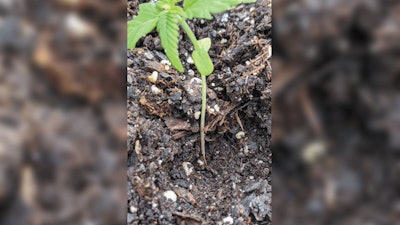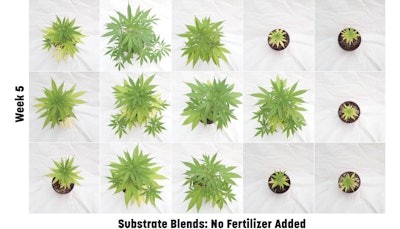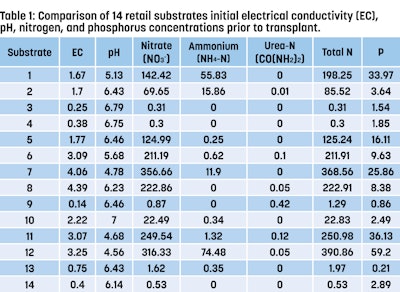
Many retail-focused, commercially available substrates advertise increased plant and root growth compared to their competitors. Often, this is a result of organic and/or nonorganic pre-plant fertilizer charges that are included in the substrate to supply longer-term fertilizer requirements to the plant.
While home growers can generally operate as usual with these substrates, commercial growers need to understand how these season-long pre-plant charges impact the chemical properties of the substrate, and what production system adjustments are needed when using these products. Although the substrates examined generally target home and small commercial growers, some are used by larger commercial growers. Commercial substrates still generally have a pre-plant starter charge, as well. While it tends to be smaller, it still needs to be considered, as it can impact chemical properties over time.

Understanding pre-plant charges
A pre-plant fertilizer charge is included during the manufacturing process and is intended to provide nutrients to the crop immediately following transplant. There are many formulations and strategies to pre-plant charges that can impact a commercial operator’s fertility planning and the overall season-long benefits to plants. For example, substrate manufacturers supply a pre-plant starter charge when adjusting the substrate pH during the blending process. In contrast, some blends are designed to provide a season-long supply of nutrients. The length of time that a pre-plant fertilizer charge lasts can vary based on rate of initial charge, substrate leaching and plant uptake.
Pre-plant charges can take the form of inorganic and/or organic granular nutrients, or of organic matter, including compost. Each formulation of fertilizer and fertilizer input will have varying impacts on the plant’s growth and your fertility program.
If nutrients from the pre-plant charge are inadequate before additional fertilizer is provided, transplants can become stunted and weak. If adequate fertilizer is present in the substrate and fertilization begins, over-fertilizing or fertilizer waste can result. Thus, knowing your pre-plant charge will allow your transplants to thrive, help avoid fertilizer waste, and keep operations at peak economic efficiency.
Growers generally supply plants with fertilizer after transplant. Post-plant fertilizer comes in many forms, ranging from water-soluble fertilizers to controlled-release or slow-release fertilizers. Growers can utilize a combination of these two strategies: A pre-plant fertilizer charge to help encourage plant growth initially, followed by post-plant fertilization. This is why growers should test the chemical properties of their substrate to optimize their fertilization program if pre-plant charges are included.

Adjusting post-plant fertilization
At North Carolina State University (NCSU), we examined the effects of 14 different retail-focused, peat-based substrates’ pre-plant charge on the substrate pH, electrical conductivity (EC) and plant growth, both with and without additional fertilizers. (Some substrates incorporated coco coir and wood fiber.) Understanding which nutrients are in a substrate can help growers customize their fertility regime to optimize yield.
When looking at the substrate pH and EC across the different blends, there were large differences observed with pH, ranging from 4.56 to 7 and EC from 0.14 to 4.39 (Table 1, below). The nitrogen (N) concentration supplied by the pre-plant charge is most commonly in the form of nitrate (NO3-N) as opposed to ammoniacal (NH4-N) or urea (CO(NH2)2) nitrogen. This allows for a slower decrease in substrate pH compared to high ammoniacal or urea pre-plant charges. Additionally, the substrates that included a nitrate pre-plant charge also contained increased potassium, calcium, magnesium and sulfur in the substrate.
When plants were not provided additional fertility, substrates with a low initial EC exhibited stunted growth and chlorosis three weeks after transplant. Additionally, substrates that initially exhibited a greater EC yielded larger plants after five weeks of growth when compared to plants that had a lower initial EC (Fig. 2, above). However, when EC is excessive for young plants, stunted growth or girdling at the soil line can occur (Fig. 1, above).

The most common nutrient disorder observed across all substrates after five weeks of growth was nitrogen deficiency. Nitrogen deficiency is first observed as chlorosis of the lower foliage, which advances into entire leaves turning yellow and, in severe cases, necrosis and leaf abscission. However, when 150 ppm N (13-2-13 N-P-K) water-soluble fertilizer was supplied to all substrates, plant growth normalized (Fig. 3, above).
Plants grown in the substrates with pre-plant charges of fertilizer to jump-start growth perform best with continual fertilization—that was what they were designed for. In contrast, substrates supplied with pre-plant fertility to carry the crop during the entire growth season accumulated excessive nutrients when supplemental fertilizer was also supplied.
The results of this trial show substrates with a total-season supply of nutrients in the bag from the start and ones that rely upon the grower to provide fertilizer performed well. The key to success is to ensure the substrate and fertilization program match up to fulfill the plant’s needs.


























